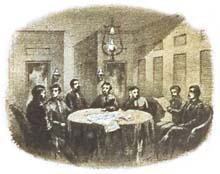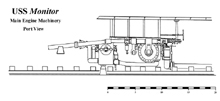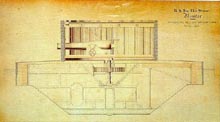
Profile view of how the USS Monitor might have looked after the ship was refitted in October 1862. (Monitor Collection, NOAA) Click image for larger view.

An artist's concept of the Monitor’s Ward Room and some of the ship’s officers as illustrated in Harper’s Weekly, April 12, 1862, (Monitor Collection, NOAA) Click image for larger view.
Archaeological drawing of the Monitor's vibrating side lever engine from the port side as it lies in the wreck. (Monitor Collection, NOAA) Click image for larger view.
Transverse plan image looking aft, showing the inside of the Monitor's gun turret and details of the midships bulkhead. (Original in the American-Swedish Historical Foundation, Philidelphia) (Monitor Collection, NOAA) Click image for larger view.
A 'Tour' of the USS Monitor
The USS Monitor represented a radical departure from traditional warship design. The first American warship with no masts and sails, the vessel was powered by steam alone. Constructed almost exclusively of iron and heavily armored, the Monitor was, in fact, almost a submarine. With barely more than one foot of freeboard, all machinery, storage, working and berthing areas were below the water line. A 5-foot high, 6-inch thick armor belt encircled the vessel at the water line for protection during battle. Perhaps the ship's most novel feature, however, was its revolving armored gun turret. Located in the middle of the ship (amidships), it was 9-foot high, 22-foot wide, and housed two 11-inch Dahlgren smoothbore cannon.
Two-section Structure
The ship was built in two sections, the upper and lower hulls. The upper hull, with its armored deck and sides, protruded only 13 inches above the water when the shipwas fully laden. The upperhull served as a platform for the gun turret and a small pilothouse located in front of it. Its low silhouette made the Monitor a very poor target for enemy gunfire. Both the upper and lower hulls were “double-ended,” meaning that the bow and stern had exactly the same shape. This must have simplified the fabrication and installation of the frames and plating -- a major consideration, since the Monitor was built on an extremely tight schedule.
The smaller lower hull was well below the waterline and inset from the armored upper hull; thus, the structure was completely protected from enemy fire and ramming. Internally, the Monitor had one structural bulkhead that was located amidships. This bulkhead was made up of a series of 1/2-inch thick iron plates that were fastened together. At each of the outboard ends of the bulkhead was an oval hatch opening 5-foot high and 30-inch wide. These hatches were fitted with hinged iron doors, which, when secured, provided an "airtight” fit between the ship’s living spaces (forward) and the engineering/galley area toward the back (aft). The turret support truss was riveted to the forward face of the midships bulkhead and provided additional support for the turret and some of the components associated with its operations.
Housing the Officers and Crew
The Monitor was the first U.S. Navy warship to house all officers and crewmen in the same section of the ship. Because all space aft of the midships bulkhead was occupied by the engine, boilers, galley, and auxiliary machinery, there was no room for the officers, who normally occupied cabins in the stern. Instead, officers’ cabins were well forward, opening into a wardroom. The crew members berthed just aft of the wardroom in a single space they had to share with storerooms and machinry. Because the officers and crew were required to spend most of their time below decks, the Monitor was equipped with a forced-air ventilation system and the world’s first below-the-waterline flushing toilets.
The Engine
The Monitor’s 400-horsepower “semi-cylinder" engine had two pistons in a single housing. It operated on a horizontal axis, applying rotation to the propeller shaft at a 90-degree angle from the cylinders and utilizing a series of rockshafts, links and levers.This reduced the height of machinery so that it could be installed in the Monitor’s tight quarters, thus affording the engine full protection from enemy guns.
The Turret
The Monitor’s famous revolving gun turret was an innovation that can still be seen on modern warships. The inside diameter of the turret was 20 feet, just enough space for the two large cannon and their gun crews. The walls of the turret were made up of eight layers of 1-inch thick iron plates, all bolted together to form an armored cylinder. The height of the turret was 9 feet. The turret revolved under the force of two small steam engines that drove a series of gears. The principal value of the turret was that it allowed the guns to train on a target almost independently of the ship’s heading. Traditional warships of the day had tomaneuver until their sides faced the enemy, because their guns could not be adjusted sideways by more than a few degrees.
A Legacy
The Monitor’s many unique features, her success in battle against the Virginia, and the worldwide fame she garnered, all contributed to her nearly mythical reputation. She was not without flaws, however. The engine room and living quarters reached dangerously high temperatures during warm weather, the turret allowed water to leak into the spaces below, and the pilothouse was so isolated from the turret that it was difficult to coordinate actions during battle. There were other problems as well with this new design. Nevertheless, the Monitor’s form and features were copied in America and elsewhere, resulting in 66 "Monitor-type" vessels being constructed in the U.S. alone. Few other ships in history can claim such a lineage.
Sign up for the Ocean Explorer E-mail Update List.
























